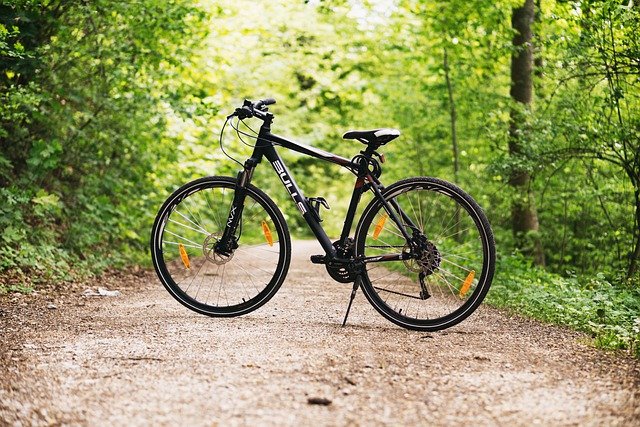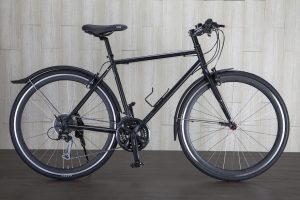Two-wheelers from all over swarm to ski resorts with bike parks when they want to let a chairlift handle the hard work. In North America, there is no shortage of downhill mountain bike parks. What are the best downhill mountain bikes?
The best downhill mountain bikes include: Mondraker Summum, YT Industries Tues 29, Commencal Supreme DH 29-27, Canyon Sender CFR, Specialized Demo, Atherton Bikes DH Bike, First look at Atherton Bikes, Scott Gambler 900 Tuned…
Please continue reading as I will present you with more specific information.
Table of Contents
Best Downhill Mountain Bike
Mondraker Summum
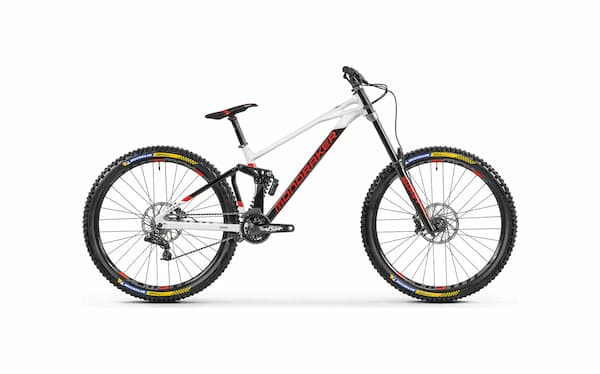
Size: S, M, L, XL
Wheel size: 27.5”, 29” or 29/27.5”
The downhill racing industry can be credited with sparking the modern geometry revolution with Mondraker’s Summum: when the Forward Geometry frames from a Spanish brand that were long, low, and extremely slack were revolutionary.
The Summum has undergone changes for 2021 as a result of input from its illustrious World Cup competitors (Laurie Greenland won a World Cup in 2019; Brook MacDonald made one of the greatest comebacks in sport history from an injury in 2020; Eleonora Farina frequently places on the podium). Since carbon fiber bikes are becoming increasingly rare on the World Cup downhill circuit, it’s either aluminum or nothing for 2021.
In modern downhill technology, wheel size is not a one-size-fits-all factor. Racer setups vary, so Mondraker provides dedicated 29-, 27.5-, or mullet-length (29.5/29.5) options of this most recent and possibly best Summum.
YT Industries Tues 29
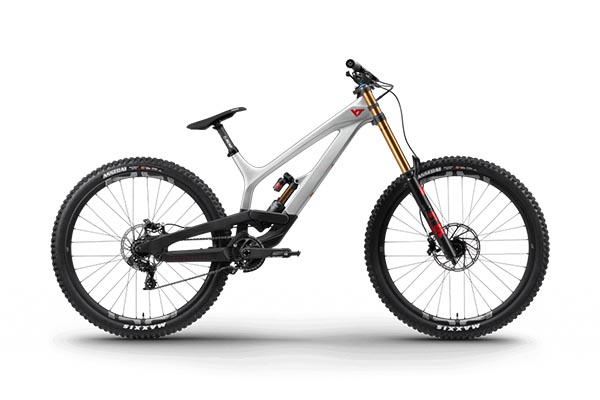
Size: S, M, L, XL
Wheel size: 29”
With the signing of Aaron Gwin in 2016, YT Industries transformed the perception of direct-sales-only brands. Could a bike with such a low price point compete with the World Cup racing behemoths? Undoubtedly. After winning the season’s opening race in Lourdes, Gwin went on to win back-to-back World Cup championships in 2016 and 2017. Another top DH athlete, Vali Höll, has taken over flying the YT flag with style while the legendary American is now riding for Intense. Höll won the junior women’s World Cup and World Championships titles in 2018 and 2019 and set the fastest elite qualifying time at the 2020 World Champs.
The Pro and Pro Race are the two top-tier carbon 29″ models in the Tues 29 lineup, and both offer incredible build kits for the price. The Pro Race fits all the requirements if you want to compete in downhill races at the highest level.
Beyond professional racing, the Tues 29 is a very rideable bike that is equally at home with casual enthusiasts and bike park riders as it is with World Champions. A wide range of prices are available for models with 27.5” wheels and smaller.
Commencal Supreme DH 29-27
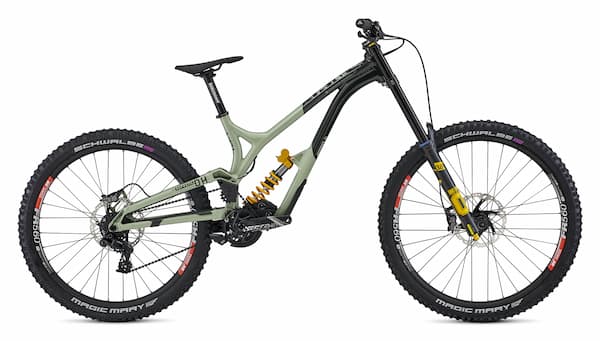
Size: S, M, L, XL
Wheel size: 29” (front)/27.5” (rear)
Get yourself on the nearly exhaustingly race-proven Supreme DH if you want to travel as quickly as riders like Amaury Pierron, Myriam Nicole, Rémi Thirion, and the recently crowned World Champion Camille Balanche. in particular, this most recent version of the mullet with its large 29-inch front wheel and smaller 27.5-inch rear wheel.
The bicycle’s high pivot point, idler-pulley construction, and progressive sizing and angles (read: long and slack) help the Supreme consume everything in its path. Because of this, it is without a doubt the most popular bike used in World Cup downhill competition, with numerous teams using it to capture countless victories and titles.
Canyon Sender CFR
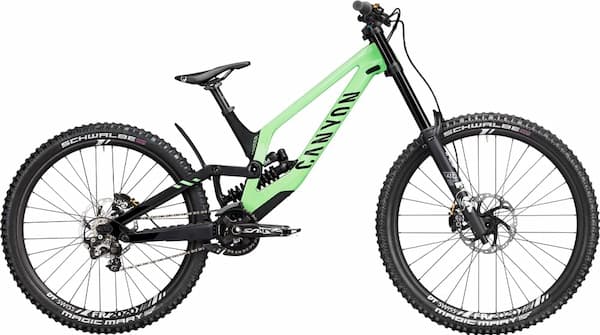
Sizes: S, M, L, XL
Wheel size: 29” or 29/27.5”
Based on Troy Brosnan’s and Tahnee Seagrave’s recent World Cup racing experience, Canyon’s Sender CFR (Canyon Factory Racing, although it is also made of carbon fiber) has undergone a complete makeover for 2021.
The Sender is a racer’s and mechanic’s dream thanks to its adjustable chainstay length and reach, practical features like easily accessible shock hardware for simple servicing or adjustments (sounds basic, but not many companies achieve this), and its progressive but sensitive suspension platform.
The Sender comes with 29″ wheels in its larger sizes, while small and medium bikes come with a mullet 29/27.5″ setup, demonstrating once more that there is no clear consensus on wheel size for downhill racing.
With some of the best parts money can buy, the Sender CFR model comes prepared for racing. As a side note, Canyon also offers the CFR FMD, a replica build if you’re a big fan of Seagrave’s Canyon Collective setup.
Specialized Demo
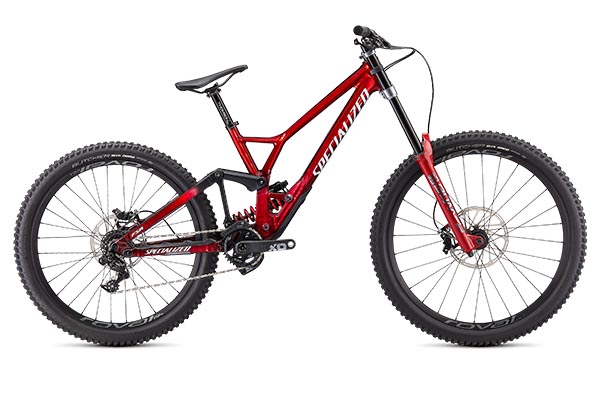
Size: S, M, L
Wheel sizes: 29” or 29/27.5”
The bike used and developed by multiple World Champion Loïc Bruni and his teammate Finn Iles is the most recent iteration of Specialized’s venerable Demo series.
The Demo retains its 2019–20 aesthetic, but if you look closely, you can see new geometry flip-chips that give the chainstays three length options. Despite being ridden by Bruni and Iles to numerous victories with a mullet 29/27.5″ wheel setup, the same bike can accept a 29″ rear wheel for more stability by simply sliding the geometry chips to the longer settings.
Despite the fact that it is entirely up to you, Bruni and Iles almost always use 27.5-inch rear wheels.
The more expensive Race model from Specialized features the finest SRAM, DT, Deity, and RockShox components money can buy. Specialized offers two build options.
Atherton Bikes DH Bike
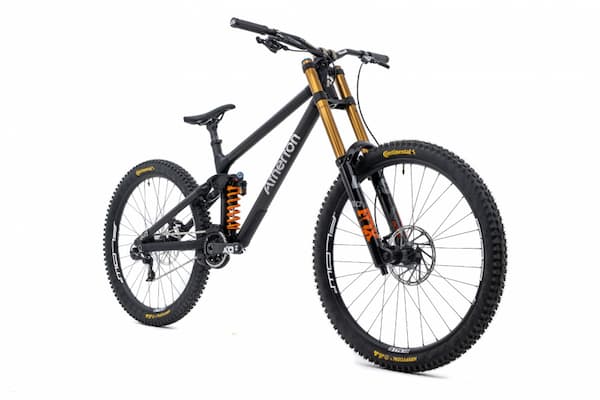
Size: Infinite
Wheel size: 29”/27.5”
The Atherton family likes to do things their own way, so no one could have predicted when they announced they would be producing their own line of bikes that they would also be using such a cutting-edge methodology to produce their race rigs.
The titanium frame junction lugs are produced by Atherton Bikes using additive manufacturing technology, which is somewhat similar to 3D printing, but don’t let them hear you say that. In contrast, carbon tubes are cut to length and assembled using glue that is extremely, extremely permanent. This enables them to quickly prototype new bikes, enabling them to arrive at each race with a frame that is optimized for the track.
The most recent version, as used by Gee Atherton, is a mullet setup with a bigger 29″ front wheel and a 27.5″ rear wheel, though Atherton Bikes would probably be able to make you a bike to fit whatever wheelsize you want. Bikes are now available to the general public for the first time in 2020, but if you want to secure one of the few build slots, you’ll need to keep an eye on the Atherton Bikes website and social media.
The Atherton siblings have changed biking as a sport. They are now working together to develop an “ultimate range of bikes” with the help of US-based suspension designer Dave Weagle.
Scott Gambler 900 Tuned
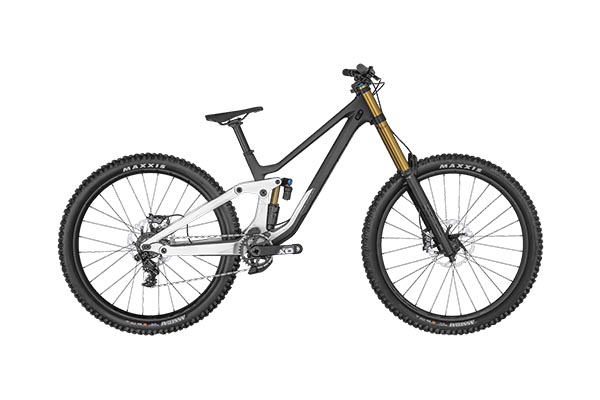
Size: S, M, L, XL
Wheel size: 27.5″ or 29”
Marine Cabirou is a dominant force in World Cup downhill racing; she won the first race of 2020 by a huge six seconds and the final three competitions of 2019. You need a good bike for riding at that speed: the Stylish Scott Gambler 900 Tuned, used by Brendan Fairclough for Red Bull Rampage, is ridden by a Frenchwoman.
The Gambler is no exception to Scott’s rule that he never leaves any loose ends. The frame’s adjustable geometry enables you to use 27.5- or 29-inch wheels, adjust the chainstay length, and even choose your head angle. It also comes with a variety of headset cups. You can choose your preferred ride feel by adjusting the suspension kinematics with the adjustment hardware.
A front fender mudguard, built-in frame protection, and Syncros’ distinctive Hixon integrated handlebar and stem are just a few of the nice extras included with the Gambler 900 Tuned. Similar to Santa Cruz’s V10, it is a very expensive bike that is extremely well made, light, and quick. However, after you’ve used it to win a few World Cup races, its value for resale should remain high.
Santa Cruz V10
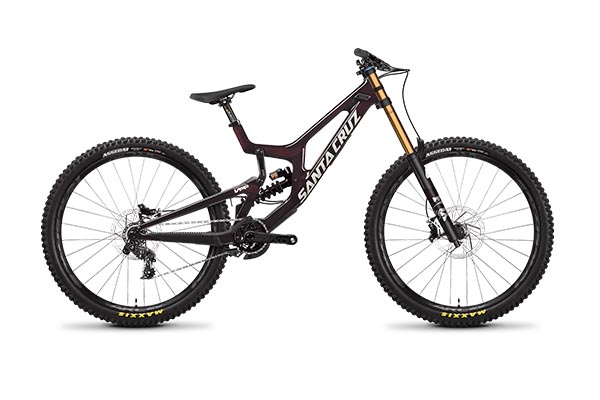
Size: S, M, L, XL
Wheel size: 27.5- or 29-inch
Santa Cruz is credited with starting many of the established trends in today’s downhill mountain bikes. The Californian company has no qualms about experimenting with cutting-edge technology, and the V10 downhill bike has been a trailblazer for evolution throughout its existence (since 2002).
A World Cup downhill race was won by a carbon-fibre bicycle. Furthermore, it became the first 29er downhill bike to triumph. Santa Cruz engineers were constantly looking into the possibility of making longer frames with more space for rolling bigger wheels in order to accommodate multiple world champion Greg Minnaar.
The 29er wheels and 215mm of travel on the V10 are combined with a complex suspension linkage. The mountain bike is merely a downhill rocket sled.
Pivot Phoenix 29
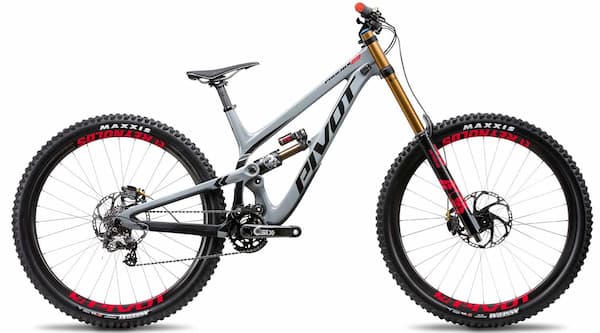
Size: S, M, L, XL
Wheel size: 29-inch
a 29-inch all-carbon downhill bike with suspension that was created by renowned kinematics expert Dave Weagle.
The leverage curve of the Phoenix is especially well suited to the most recent generation of high-volume air shocks. Even though it has a little less travel than its competitors, it has the Superboost 157mm rear axle spacing. You will have the width to assemble a 29er wheel with incredibly high strength thanks to this incredibly generous rear hub spacing.
Pivot’s big-wheel downhill bike has a 62.5-degree head angle, so even when it seems like you are trying to go down features that are too intimidating, you’ll remain confident. This makes it ideal for riders who are drawn to riding the steepest of technical tracks.
Trek Session 29 9.9
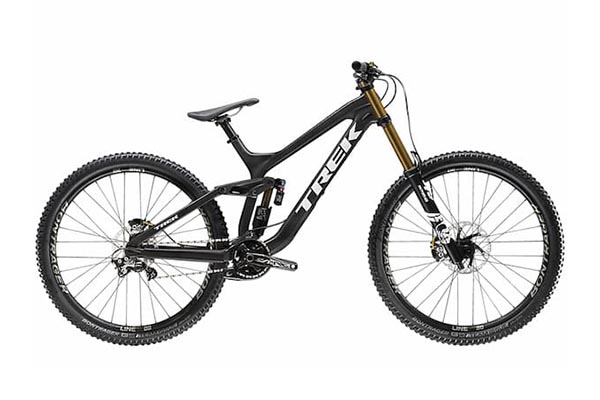
Size: S, M, L, XL
Wheel size: 29-inch
The legendary Trek Session downhill bike has maintained a fair amount of its familiarity over time. The Trek Session has a recognizable silhouette and a rocker-arm actuated suspension system.
The Session’s travel was reduced to 190mm by an upgrade to larger 29-inch wheels. There is enough downtube protection in the form of a special moulding over the carbon fiber to shield the frame from impacts with rocks and trail debris.
The Session 29 is certainly slack even though it may not be the longest downhill bike. You can confidently take off from even the most dizzying drops thanks to the 62.1-degree head angle.
Canyon Sender 6
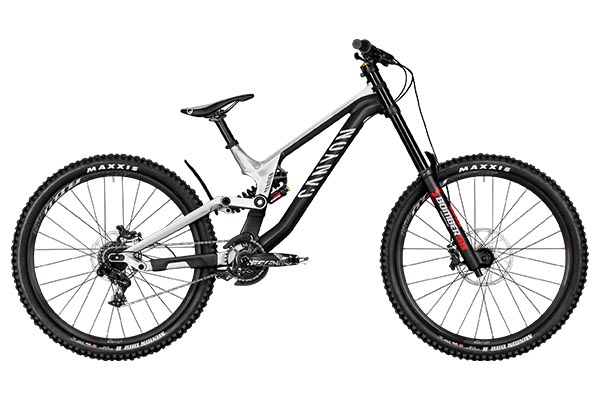
Size: S, M, L, XL
Wheel size: 27.5-inch
The German direct-sales company provides outstanding value. You can choose between an aluminum or carbon frame for its Sender, and whichever one you select: they are incredibly priced for what they offer.
The German company Canyon has resisted the urge to follow extreme geometry trends and continues to stick with the 27.5-inch wheel size for its downhill bicycles (for the time being). Despite having a head angle of 63 degrees, which is very slack, the Sender is not an excessively long bike, unlike some of its competitors.
The Sender’s rear suspension linkage has been improved to work with the newest high-volume air shocks and provides 203mm of travel.
The Sender would be best suited for riders who enjoy maneuvering the bike with significant rider input rather than simply being a passenger downhill, depending on the frame’s inherent stability, due to its small size and agile geometry.
How Do You Ride Downhill?
On a fire road in the early 1970s, the first downhill race got underway. Since bicycle suspension wasn’t yet a thing, riders rode Schwinn bikes with rigid frames.
Since then, both the technology of downhill bikes and the associated courses have advanced quickly. Today’s professionals are riding things that were unthinkable fifty years ago, including: scree fields, mountainsides, and even moderate rock climbs.
Downhill mountain bikes are also known as Gravity bikes due to the momentum provided by the gravitational direction from high elevations. Due to the fact that mountain bikes are only used for riding downhill, riding them on flat ground can be challenging. See more about Best Dirt Bike For Trail Riding
Is Downhill Mountain Biking A Risky Activity?
Risk is present in all forms of cycling to some extent. But compared to other forms of riding, downhill riding is unquestionably riskier because it involves big jumps and fast speeds. The majority of DH riders wear full-coverage helmets, knee, shoulder, and hand armor.
Riders must have this personal safety gear in order to use the lifts at many downhill parks. Fortunately, there are numerous downhill runs available at various difficulty levels. Modern 4-cylinder hydraulic brakes significantly increase trail safety and confidence.
Considerations For Downhill Mountain Bike
Suspension
The goal of all designers has been to maximize suspension travel and kinematic function ever since the introduction of downhill-specific racing frames in the late 1990s. The fact that all of the bikes on our 2020 list have rear suspension travel measurements between 190 and 215mm is telling.
Bike axle-to-axle distances were much smaller when 26-inch downhill frames were the only option, but they had enormous travel reserves. A mid-2000s downhill bike with 250mm of rear suspension stroke was not unusual. That’s just not true anymore.
Suspension numbers in downhill racing are not always what they seem. Shock rebound characteristics can be severely harmed by excessive rear-suspension travel. Designers began shortening the rear travel of downhill bikes as larger diameter wheels came into vogue, which could lessen the effects of the terrain. This made the suspension behavior of these bikes more predictable over brutally technical terrain.
Many people were persuaded by the development of air-shock technology that having the best internals and shim designs was actually preferable to having the most outright millimeters of travel.
Geometry
In an effort to build downhill bikes with the longest fork and rear shock travel possible, geometry was long ignored by designers. But in the recent years, everything has changed.
Given the gradients and terrain they race on, downhill bikes require more stability than any other type of mountain bike design. Any bike’s riders are positioned more in the middle with a longer wheelbase or even just a longer front triangle. Rider positioning is even more important on downhills because of the steep gradients that they descend.
Greg Minnaar, who has won multiple downhill racing championships and is regarded as the greatest rider in the sport, has been credited with bringing about a revolution in downhill bike geometry and design. At 1.9m, downhill rider Minnaar is an unusually tall person. He began promoting the advantages of a longer frame because he has always felt uncomfortable on most downhill bikes.
As a result, it is now generally acknowledged that a longer frame is more advantageous for downhill riders, especially those who are larger. The value of 29er wheels on downhill bikes was another important accomplishment of Minnaar’s. Downhill bike designers steadfastly stuck with 26-inch wheels despite the obvious advantages of larger wheels for rolling over rougher terrain.
Wheel Size
Nobody thought a 29er downhill bike would function once 27.5-inch wheels were adopted. Inferred to be too awkward were they. And it was decided that it was an unnecessary engineering challenge to try to design a frame that would allow for extreme front and rear suspension travel while still providing enough clearance for 29-inch wheels.
After introducing one in 2017, Minnaar’s theory—which he had persuaded Santa Cruz would work—was proven correct. The majority of the better downhill bikes available in 2020 use the 29er wheel size, which does provide unparalleled traction and stability when tearing through challenging rock gardens. This technology was once unthinkable.
The smaller wheel size is also available for many of the current 29er downhill frames. This choice will appeal to downhill purists who prefer the simpler handling (and correction) of a smaller wheeled 27.5-inch bike in the air.
Conclusion
The main focus of downhill racing is bulldozing through the most difficult, gnarly terrain imaginable while descending a mountain at breakneck speeds. No matter how challenging, steep, or fast the going becomes, the winner is the one who manages to stay composed, calm, and focused on getting from point A to point B in the shortest amount of time possible.
The top downhill bikes are made to meet a number of requirements: strong, light, stable, forgiving and fast. Different frame designs, materials, wheel sizes, and other components are used to accomplish this.
We appreciate you reading.

